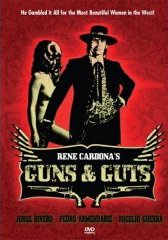
A gun-smoking bullet in the side of the amazingly simplistic, emotionally banal, and intellectually lazy formula Westerns of America (and to a lesser extent Europe), which prized bland adherence to some non-existent code of Chivalry when re-creating the west instead of realism, the Spanish-Italian western genre is as known for challenging morally rigid, unrealistic championed moral caricatures of the status quo as it is for kicking a spur in codes of acceptable cinematic representations of violence, shocking the cinematic world with unabashed celebrations of brutality, sleaze, and emotional harshness.
Showing how the west truly was in terms of moral ambiguity and violence, the Spaghetti Western (once a term of defamation now heralded as a byword for a specialist style and tone) was as unflinchingly honest in its emphasis on the inner realties of characters as it was in capturing the stylish violence and bloodied results of its gunfights. Neither wholly good nor evil but somewhere in between, the characters in a majority of these films are neither heroes or villains - they are both, more closely resembling the human animal in his warring instincts to both harm and heal. In Guns and Guts, Man does both, combining the aforementioned emphasis on style, violence, and ambiguity of character with rough romanticism. Poetic moments between life and death are of visually stunning as tumble-weeds float over mud-cracked streets, and love and death bleed together beneath a harsh sun.
Two escaped convicts team resources and attitudes (and, boy, do they have them!) to challenge a corrupt sheriff (Quintin Bulnes) in dusty Santa Fe. Traveling together in an aesthetic nod to the 'bonding' sub-genre, they soon accept a third member in their putrid posse, a hired gun (Jorge Rivero), whose fast draw is only matched by his libido. A philosopher of flesh, he waxes poetic on whores and the carnal carnivals he's attended in the bedroom, lending a current of humor into a film evoking an atmosphere of anger, decay, and moral stagnation. Wrestling with his ability to kill and cowardice, Armendariz hires Jorge to kill the sheriff. When the later agrees, asking for twice the bounty, a further complication of greed throbs beneath the subtext. While Jorge's rather bizarre plot to befriend the sheriff (resembling the major plot movement in Leone's A Fistful of Dollars, with Eastwood's character playing opposite camps of enemies against the other), tension further develops. We discover that Armendariz and Guerra don't agree with the plan, and are regretting their enlistment of Jorge. It's not long before this screenplay follows suite with the grand western tradition of back-stabbing, convoluted plotting, and bloodily satisfying violence.
Refusing to play it safe during an artistic and cultural era when a majority of crime films were still reinforcing a naïve insistence on the heavy-handed, one-sided moral rigidity of unbendable Good vs. inflexible Evil, this western finds lechery and shadows where American films would only admit to seeing black-and-white stereotypical definitions of heroes and villains. As intelligent as it is rowdy, unrepentantly daring in execution, and cynically ruthless in its depiction of dirty angels, this wicked western is rude and rambunctious, its enthusiasm and stylistic verve surmounting a somewhat plodding story (particularly in the middle) and low budget. If anything, the gritty look of the film, as well as the minimal yet poetically bleak landscape, furthers themes of isolation, amorality, and decay. Not only the buildings and countryside are decrepit, but so are the people who populate them. This marriage between form and content, look and theme, is surprisingly ambitious.
While the pace of this torrid tale of dueling guns and guts occasionally lags, generous splashes of nudity, violence, and gore blaze across the screen. Of distinctive appeal to the gratuitous gore-met is a shoot-out between Jorge and a drifter, where the blood flies like Niagra Falls! Depicting death as the painful and wasteful terror it is, the filmmakers also paradoxically treat violence in a loving, voyeuristic manner, framing these scenes with the artistry of a painter. The subject? The body as meat! A meaty ménage of Sam Peckinpah and Sergio Leone, with underpinnings of the political sensitivity that characterizes such films as Run, Man, Run!, Guns & Guts interweaves guns, fistfights, and men at their worst in a finale which delivers the obligatory apocalyptic showdown.
Presented in a suitable transfer, the anamorphic 2.35.1 widescreen displays some grain, yet this doesn't hamper enjoyment overmuch, and the Dolby Digital Mono track, dubbed, lends the feature a sense of drive-in nostalgia. While extras are sparse, consisting of trailers, they are enjoyable. Good and evil are but terms in this film. An undeniable sense of cosmic loneliness and hopelessness presides, emphasized by instinctive if not refined direction and workmanlike cinematography that, while hardly inspirational, does capture the emotional wilderness of the landscape -- itself a mirror of these men's souls. Standing tall and facing down your death like a man is the only saving grace, and a bloody, unpleasant one at that. Grim yet poetically handled, this celluloid shoot-out is a minor yet intriguing addition to the western cannon
Review by William P Simmons
| Released by VCI |
| Region 1 - NTSC |
| Not Rated |
| Extras : |
| see main review |